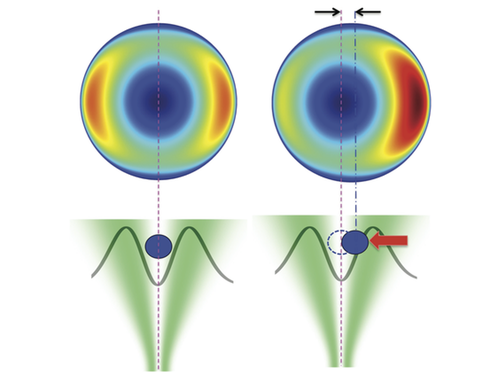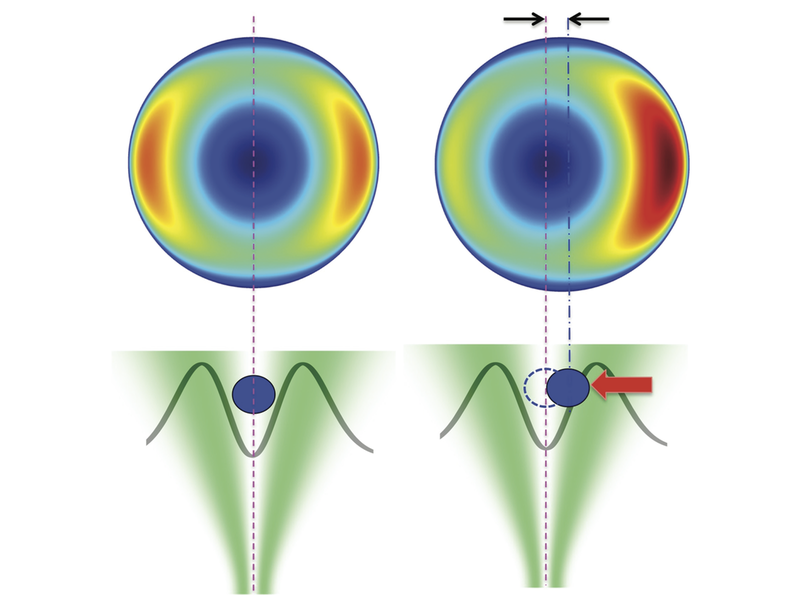Optical Funnel Traps Particles
Researchers have designed a funnel-shaped light beam that uses a thermal force to push objects toward the central axis of the beam. This “optical funnel” could focus a stream of biological molecules into the small target region of an x-ray laser, allowing their structure to be determined without the need to create crystals of the biomolecules. To demonstrate the funnel’s potential, the team characterized the forces in the beam by orienting it vertically and using it to levitate micrometer-sized beads. They then ran simulations based on the levitation results, which showed that moving particles could be channeled into a small region, as required for the x-ray experiments.
Optical trapping, such as with optical tweezers, typically relies on direct light forces (momentum transfer or electric field effects) to manipulate a target object immersed in water. Thermal effects are minimized because the water carries heat away. However, in a gas, the lower thermal conductivity of the surrounding medium allows the object to heat up on the side where the light shines, while remaining cool on the opposite side. Gas molecules collide with the hot side and bounce off with more momentum than those hitting the cold side. This momentum imbalance results in a so-called photophoretic force that pushes from hot to cold, drawing the object toward regions of lower light intensity. (The photophoretic force is behind the turning motion of a light mill, or radiometer.)
Some of the first demonstrations of trapping with this force involved an optical vortex [1], which is a beam with a helical wavefront that results in zero light intensity at its center. Researchers showed that nanometer-sized particles in air feel a photophoretic force pushing them toward the center of an optical vortex. Based on this idea, Andrei Rode from the Australian National University in Canberra and his colleagues have now developed a new sort of trap by passing a vortex beam through a lens, so that it diverges outward like a funnel. Their intention is to use photophoretic forces to concentrate a stream of particles entering the funnel from its wide end.
Concentrating a particle stream is necessary for single-particle imaging, currently being developed at x-ray free electron laser (XFEL) facilities around the world. Pulses of high-intensity x rays from the XFEL could produce atomic-scale snapshots of single, free-floating proteins or viruses. The technique would be much less laborious than the traditional approaches that require the time-consuming production of crystalline samples, for example.
One of the main challenges for single-particle, x-ray imaging is trying to ensure that at least one of the particles is in the 100-nanometer-wide target region each time an x-ray pulse is fired. Current efforts only squeeze a particle stream down to about 50 micrometers. Other techniques do better, but they require using liquid jets that interfere with the signal by scattering x rays. “That’s why the optical funnel is so appealing,” says team member Henry Chapman from the Center for Free-Electron Laser Science in Hamburg, Germany. The trapping force works in air, and the dark center region of the funnel, where particles would be directed, is only a few micrometers wide at the narrowest point.
However, predicting the optical funnel’s operation is challenging because the photophoretic force depends on a number of factors, such as the size of the particle and the gas pressure. So Chapman, Rode, and their colleagues needed to measure the forces inside the beam. They introduced micrometer-sized graphite beads with a range of masses (1 to 100 nanograms), one at a time, into a vertically oriented funnel opening upward and measured the height at which each bead levitated. They also observed the oscillation frequencies of particles wobbling around in the funnel trap.
“The obtained map of force allowed us to predict the path of particles entering the optical funnel,” Rode says. These predictions don’t directly apply to proteins and other biological samples, since those objects don't absorb light as well as graphite beads. However, proteins have less thermal conductivity, so the temperature differences—and resulting photophoretic force—may not be all that different, Rode says. Further experiments will verify this and will also optimize the optical funnel for use in an XFEL.
“The benefit of utilizing optically induced forces of this type is that they can be orders of magnitude larger than direct optical forces generated by the same incident power,” says Peter Reece from the University of New South Wales in Sydney.
This research is published in Physical Review Applied.
–Michael Schirber
Michael Schirber is a Corresponding Editor for Physics Magazine based in Lyon, France.
References
- V. G. Shvedov, A. S. Desyatnikov, A. V. Rode, W. Krolikowski, and Y. S. Kivshar, “Optical Guiding of Absorbing Nanoclusters in Air,” Opt. Express 17, 5743 (2009).





